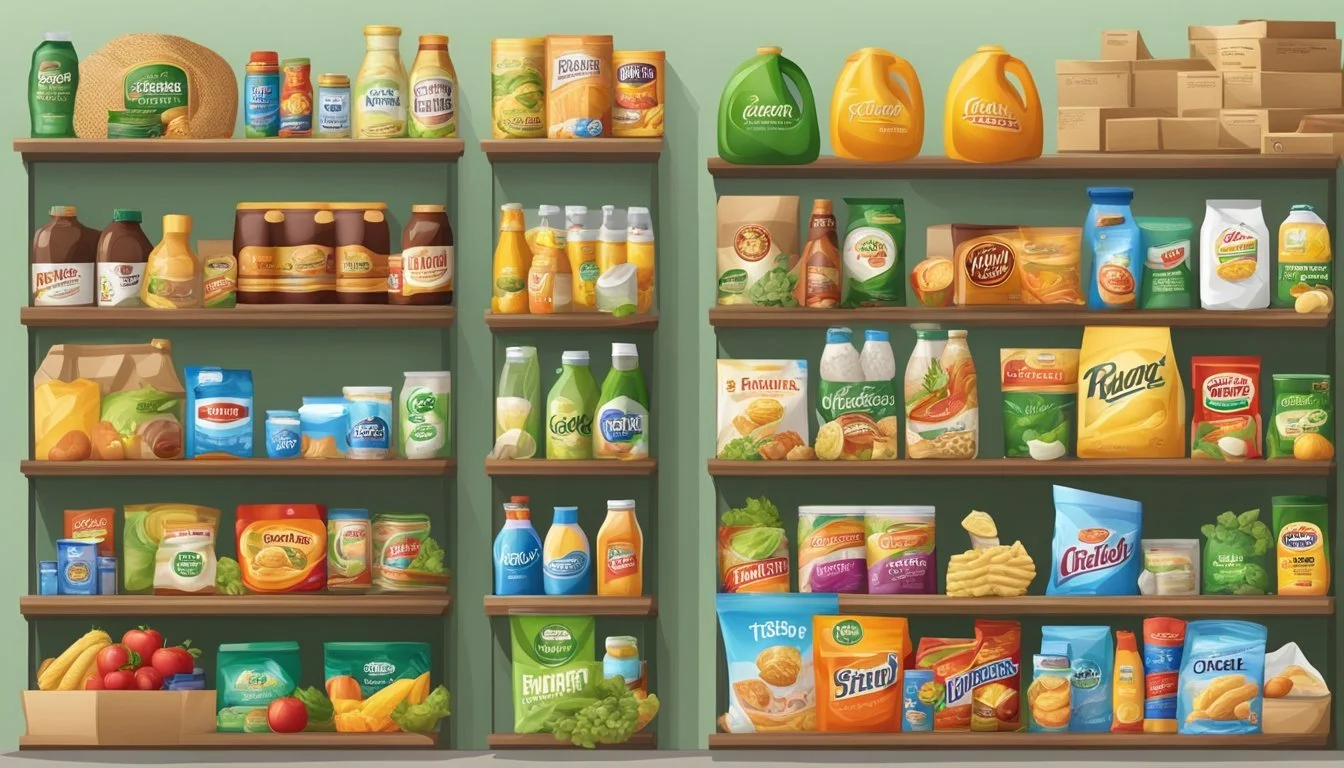Target vs Family Dollar
A Comprehensive Comparison of Price and Quality
Target and Family Dollar are two popular retail chains that offer groceries and household essentials. While both stores aim to provide value, they cater to different customer needs and shopping experiences.
Target generally offers higher quality products and a wider selection, but at slightly higher prices compared to Family Dollar. Target's grocery sections tend to be larger and feature more brand-name items alongside their own store brands. The stores also have a more upscale feel with wider aisles and modern displays.
Family Dollar focuses on budget-conscious shoppers looking for deep discounts. Their stores are typically smaller and carry a more limited selection of groceries and household goods. Family Dollar excels at offering very low prices on basic necessities, making it an attractive option for those prioritizing savings over variety or ambiance.
Overview of Target and Family Dollar
Target and Family Dollar are two prominent retail chains in the United States, each catering to different market segments.
Target is a large-format discount retailer known for offering a wide range of products. It sells groceries, clothing, electronics, home goods, and more. Target stores typically have a clean, modern aesthetic and attract middle-income shoppers.
Family Dollar, on the other hand, is a small-format discount store. It focuses on providing everyday essentials at low prices. Family Dollar stores stock household items, food, personal care products, and seasonal merchandise.
Target operates over 1,800 stores across the United States. These stores are generally spacious, averaging around 130,000 square feet. Target also has a strong online presence and offers various pickup and delivery options.
Family Dollar has a much larger store count, with over 8,000 locations. Its stores are smaller, typically around 7,000 to 9,000 square feet. Family Dollar often opens stores in urban and rural areas underserved by larger retailers.
Both chains offer groceries, but their selections differ. Target provides a broader range of fresh produce, meat, and name-brand items. Family Dollar primarily stocks non-perishable foods and a limited selection of frozen goods.
Pricing strategies also vary between the two. While both aim to offer value, Family Dollar focuses on consistently low prices across its inventory. Target uses a mix of everyday low prices and periodic sales on select items.
Pricing and Affordability
Target and Family Dollar offer different pricing strategies and savings opportunities for budget-conscious shoppers. Both retailers aim to provide value, but their approaches vary in terms of everyday prices, discounts, and loyalty programs.
Comparison of Everyday Prices
Target generally has higher everyday prices compared to Family Dollar. Family Dollar focuses on offering low-cost essentials and household items. Their smaller store format allows them to keep overhead costs down, resulting in lower prices on many products.
Target's prices are typically 10-15% higher than Family Dollar for comparable items. However, Target offers a wider selection of brands and higher-quality products in many categories.
Family Dollar excels in providing affordable options for basic groceries, cleaning supplies, and personal care items. Their private label products are often priced significantly lower than national brands.
Discounts and Savings Opportunities
Target frequently runs sales and promotions, offering deeper discounts on select items each week. Their "Circle" offers provide additional savings on featured products.
Family Dollar relies less on rotating sales, instead maintaining consistently low prices year-round. They do offer weekly specials and seasonal promotions on certain items.
Target's clearance sections often have steep markdowns, especially on clothing and home goods. Family Dollar occasionally offers clearance deals but focuses more on everyday low pricing.
Both stores use loss leaders - deeply discounted popular items - to attract customers. Target's loss leaders are often on trendy or seasonal items, while Family Dollar focuses on essential household goods.
Loyalty Programs and Additional Saving Tactics
Target's free loyalty program, Target Circle, offers 1% cash back on purchases, personalized offers, and exclusive deals. Members can stack Circle offers with manufacturer coupons for maximum savings.
Family Dollar's "Smart Coupons" digital program allows customers to clip coupons and save them to their account for use at checkout. While not as robust as Target Circle, it provides additional savings on already low-priced items.
Target's RedCard credit or debit card offers 5% off all purchases, free shipping for online orders, and extended return periods. Family Dollar does not offer a store credit card.
Both retailers accept manufacturer coupons, but Target is generally more coupon-friendly, often allowing stacking of multiple discounts on a single item.
Product Range and Quality
Target and Family Dollar offer distinct product ranges and quality levels to cater to different consumer needs. Their selections vary in terms of fresh produce, organic options, meats, dairy products, and packaged goods.
Fresh Produce and Organic Options
Target provides a wider array of fresh produce and organic options compared to Family Dollar. The retailer stocks a variety of fruits, vegetables, and organic items in many of its locations. Target's produce section often includes high-quality organic produce and specialty items.
Family Dollar, on the other hand, has a more limited selection of fresh produce. Their focus is primarily on basic fruits and vegetables rather than organic or specialty items. The quality of produce at Family Dollar can vary by location.
Meat and Dairy Products
Target offers a broader range of meat and dairy products than Family Dollar. Target's meat department typically includes fresh cuts, poultry, and seafood options. Their dairy section features various milk types, cheeses, yogurts, and plant-based alternatives.
Family Dollar's meat and dairy offerings are more limited. They mainly stock frozen meats and a smaller selection of dairy items. The emphasis is on affordable, basic options rather than premium or specialty products.
Packaged Foods and Store Brands
Both retailers offer packaged foods and store brands, but with different emphases. Target's selection includes a mix of national brands and its own store brands like Good & Gather and Market Pantry. These store brands often provide quality comparable to national brands at lower prices.
Family Dollar focuses more on generic staples and budget-friendly options. Their store brands aim to offer the lowest prices possible. The retailer stocks a range of packaged foods, snacks, and beverages, prioritizing affordability over variety.
Target's packaged foods section tends to be more extensive, including specialty and gourmet items. Family Dollar's selection is more basic, catering to essential grocery needs.
Store Experience and Shopping Convenience
Target and Family Dollar offer distinct shopping experiences. Each store's layout, checkout process, and delivery options shape the overall convenience for customers.
Store Layout and Navigation
Target stores typically feature wide, well-lit aisles with clear signage. Departments are organized logically, making it easy for shoppers to find what they need. The grocery section is often located near the entrance, with fresh produce, dairy, and frozen foods in separate areas.
Family Dollar stores have a more compact layout. Aisles tend to be narrower, with a mix of food and household items throughout. While this can make specific item searches challenging, it allows for quick browsing of multiple categories in a smaller space.
Target's layout caters to leisurely shopping, while Family Dollar focuses on efficiency for grab-and-go purchases.
Checkout Efficiency and Convenience
Target offers multiple checkout options. Self-checkout kiosks are available for quick trips, while staffed lanes handle larger orders. Many locations have dedicated express lanes for customers with few items.
Family Dollar typically relies on traditional cashier-operated checkouts. Lines can form during busy periods due to fewer open registers. Some stores have started implementing self-checkout options to improve efficiency.
Target's varied checkout choices often result in shorter wait times compared to Family Dollar.
Grocery Delivery Options and Features
Target partners with Shipt for same-day delivery services. Customers can order groceries and other items through the Target app or website. Prime member deals are not applicable, as Target is not affiliated with Amazon.
Family Dollar has limited delivery options. Some locations offer in-store pickup for online orders, but full-scale grocery delivery is not widely available.
Target's robust delivery service gives it an edge in convenience for customers who prefer shopping from home. Family Dollar focuses more on in-store experiences for budget-conscious shoppers.
Customer Satisfaction and Store Policies
Target and Family Dollar employ different strategies to attract and retain customers. Their approaches to customer satisfaction and store policies reflect their distinct market positions and target demographics.
Consumer Ratings and Feedback
Target consistently ranks higher in customer satisfaction surveys compared to Family Dollar. A recent study showed Target scoring 4.2 out of 5 stars in overall customer experience, while Family Dollar received 3.7 stars. Customers praise Target for its clean stores, wide product selection, and helpful staff. Family Dollar receives positive feedback for its affordable prices but faces criticism for long checkout lines and limited inventory.
Target's mobile app garners high ratings, with users appreciating features like in-store navigation and digital coupons. Family Dollar's app, while functional, has fewer features and lower user engagement. Online reviews indicate that Target's customer service is more responsive to complaints and resolves issues faster than Family Dollar.
Privacy Policies and Customer Trust
Target implements a comprehensive privacy policy that outlines how customer data is collected, used, and protected. The company provides clear opt-out options for marketing communications and allows customers to access and delete their personal information. Target has invested in advanced cybersecurity measures to safeguard customer data.
Family Dollar's privacy policy is less detailed but complies with basic data protection standards. The company collects less customer data overall due to its limited online presence and fewer digital services. Both retailers have faced data breaches in the past, but Target's response and subsequent security improvements have helped rebuild customer trust.
Target offers a more robust loyalty program, which some customers view as a fair exchange for their data. Family Dollar's simpler approach appeals to shoppers who prefer minimal data sharing.
Market Presence and Consumer Base
Target and Family Dollar have distinct market presences and appeal to different consumer segments. Their regional availability, store formats, and customer demographics shape their competitive positions in the retail landscape.
Regional Availability and Accessibility
Target operates over 1,800 stores across all 50 U.S. states, with a strong presence in urban and suburban areas. Its larger format stores are typically found in shopping centers and standalone locations.
Family Dollar has a more extensive network of over 8,000 stores, focusing on rural and urban neighborhoods. These smaller format stores are often located in strip malls or standalone buildings on main streets.
Target's stores are generally more spacious, averaging 130,000 square feet. Family Dollar locations are compact, usually around 7,000-9,000 square feet.
Brand Loyalty and Demographics
Target attracts a middle to upper-middle-income consumer base. Its "expect more, pay less" slogan resonates with shoppers seeking quality products at reasonable prices.
Family Dollar caters primarily to low to middle-income households. Its focus on everyday essentials and discounted prices appeals to budget-conscious consumers.
Target has cultivated a loyal following among millennials and young families. Its exclusive designer collaborations and trendy home decor options contribute to its popularity.
Family Dollar's core customers are often older adults and families in need of affordable household basics. The chain's frequent promotions and dollar deals help retain price-sensitive shoppers.
Target's e-commerce platform complements its brick-and-mortar presence, attracting tech-savvy consumers. Family Dollar maintains a simpler online presence, focusing on in-store experiences.
Comparative Analysis of Common Items
Target and Family Dollar offer many common grocery items, but prices can vary significantly between the two stores. A comparison of frequently purchased products reveals interesting patterns.
Staple foods like bread, milk, and eggs tend to be cheaper at Family Dollar. For example, a loaf of white bread costs $1.25 at Family Dollar versus $1.89 at Target.
Canned goods and boxed meals also favor Family Dollar in price. A can of soup averages $0.99 at Family Dollar compared to $1.29 at Target.
Target takes the lead on fresh produce pricing. Bananas cost $0.59 per pound at Target versus $0.69 at Family Dollar. Apples and oranges follow a similar trend.
For personal care items, Family Dollar often has lower prices. Toothpaste, shampoo, and deodorant typically cost 10-20% less than at Target.
Cleaning supplies show mixed results. Laundry detergent is generally cheaper at Family Dollar, while all-purpose cleaners cost less at Target.
Pet food and treats are more affordable at Target. A 16-pound bag of dry dog food costs $14.99 at Target compared to $16.99 at Family Dollar.
Frozen foods and snacks tend to be priced lower at Family Dollar. Ice cream, frozen pizzas, and chips average 5-15% less than Target's prices.
Final Thoughts: Determining the Better Choice
Target and Family Dollar cater to different grocery shopping needs. Target offers a wider selection of products, including fresh produce and name-brand items. Their stores generally provide a more pleasant shopping experience.
Family Dollar focuses on budget-friendly options, with a smaller but carefully curated selection. Their prices are often lower, especially on everyday essentials and household goods.
For quality, Target tends to have the edge. Their store-brand products are well-regarded, and they offer more organic and premium options. Family Dollar's quality is decent for the price point but may not match Target's standards.
Those looking to save money on basic groceries may find Family Dollar more appealing. However, Target's frequent sales and loyalty program can offset higher prices for savvy shoppers.
Selection is where Target clearly outperforms. They stock a broader range of products, including specialty and gourmet items. Family Dollar's selection is more limited but covers most essential groceries.
Ultimately, the better choice depends on individual priorities. Budget-conscious shoppers may prefer Family Dollar, while those seeking variety and higher quality might lean towards Target.







